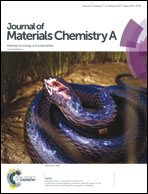A pressure-induced bending sensitive capacitor based on an elastomer-free, extremely thin transparent conductor†
Abstract
An elastomer-free, extremely thin (less than 2 μm), and highly transparent (higher than 95%) pressure–sensitive capacitor is successfully fabricated using a combination of polyvinyl butyral (PVB) and a percolated network of silver nanowires (AgNWs). The strong affinity of PVB to the polyvinyl pyrrolidone (PVP) layer, which capped the AgNWs, stabilizes the sensor mechanically to an extent that it can resist 100 000 cycles of bending under a curvature radius of 200 μm. The strong hydrogen bonding interactions and entanglement of PVB chains make the cross-linked PVB freestanding and very strong, facilitating the reduction of the thickness to less than 2 μm. The capacitance is formed on an AgNW tandem compound electrode pattern by the fringing effect, which increases with an increase in the pressure-induced bending applied to the surface of the sensor. The sensitivity is three times higher than that of an elastomeric pressure sensor with the same sensor design. The use of the AgNW/PVB sensor as a wearable acupressure sensor and a transparent motion detector is successfully demonstrated.


 Please wait while we load your content...
Please wait while we load your content...